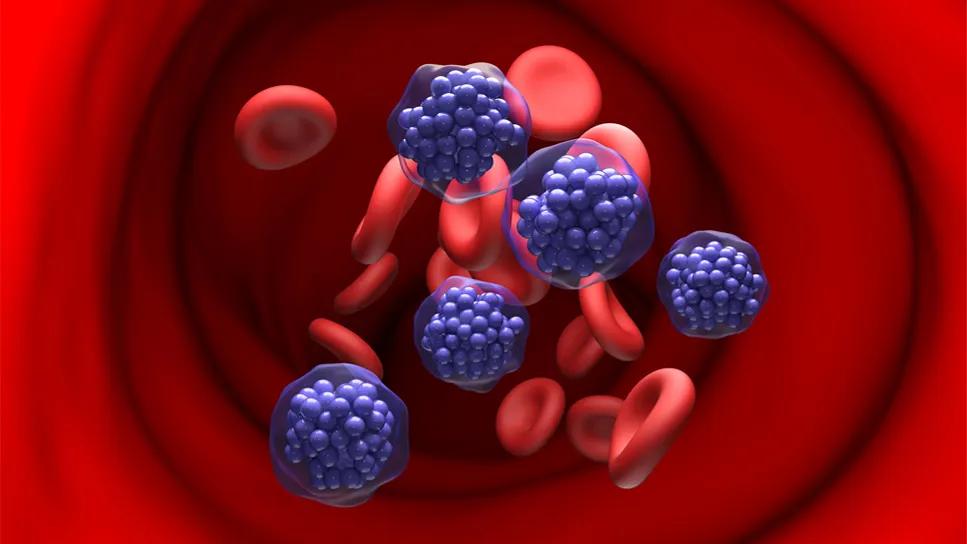CAR T-cell therapy, bispecifics and antibody drug conjugates have changed disease management

Diffuse large B-cell lymphoma (DLBCL) is relatively straightforward to manage at initial diagnosis. However, for the 20-30% of patients who don't achieve durable remission, or for those who are deemed higher risk, there have been significant treatment advances.
Advertisement
Cleveland Clinic is a non-profit academic medical center. Advertising on our site helps support our mission. We do not endorse non-Cleveland Clinic products or services. Policy
Standard front-line therapy for DLBCL has long been R-CHOP (rituximab, cyclophosphamide, doxorubicin hydrochloride, vincristine sulfate and prednisone). However, in the large phase 3 trial POLARIX, patients with international prognostic index scores (IPI) of 2-5 experienced a modest progression-free survival advantage when the antibody drug conjugate polatuzumab vedotin replaced vincristine in the R-CHOP regimen. This led to FDA approval of pola-R-CHP, which is now standard of care for patients with intermediate- to high-risk disease.
The POLARIX study found that patients with the activated B-cell subtype or ABC subtypes appear to be more sensitive to treatments with polatuzumab vedotin relative to tumors that are germinal center in origin. However, it is not routine practice to limit the use of polatuzumab vedotin to ABC subtypes because it does still have some benefit for germinal center cases, and there are few routinely available clinical tests to assess molecular subtype.
"There are still patients who unfortunately relapse or fail to respond to frontline treatment,"
says Brian T. Hill, MD, PhD, Director of the Lymphoid Malignancies Program and a staff physician at Cleveland Clinic Cancer Institute. "In those cases, chimeric antigen receptor (CAR) T-cell therapy is generally recommended for patients who are sufficiently young and fit enough. It's approved as second-line therapy, and, in the case of axicabtagene ciloleucel, has an overall survival benefit compared to standard second-line therapy, which would have been chemotherapy followed by a stem cell transplant.”
Advertisement
Roughly 30-40% of patients have the potential to be cured with CAR T-cell therapy. In some cases, CAR T-cell therapy can be administered on an outpatient basis, particularly lisocabtagene maraleucel, which tends to have lower rates of cytokine release syndrome (CRS) and neurotoxicity (referred to as immune effector cell-associated neurotoxicity syndrome or ICANS). Even if the patient isn't eligible for CAR T-cell therapy due to age or comorbidities, or has constraints that make it difficult to travel for this therapy, there are still many effective novel therapies that can be delivered locally in the community and are less toxic than traditional chemotherapy.
In cases where CAR T-cell therapy is not effective or warranted, there are several therapy approvals available, such as lenalidomide with tafasitamab and the antibody drug conjugate loncastuximab tesirine, which both target the CD19 antigen.
When second- or third-line treatment is needed, tissue biopsy is generally recommended to confirm the diagnosis but also to assess whether the tumor is expressing certain surface antigens such as CD19 or CD20. "It's quite likely that patients who do not have CD20 expression will be unlikely to respond to bispecific antibody therapy,” says Dr. Hill. “Similarly, the impact of CD19 expression on subsequent treatments like loncastuximab tesirine may be associated with lower likelihood to respond."
In those cases, therapies such as polatuzumab vedotin may be used, since it targets a different protein (CD79B). Other third-line alternatives include traditional chemotherapy targeting intracellular components, or BTK inhibitors. "These agents have some activity in DLBCL at the time of relapse, but they are imperfect in that setting,” cautions Dr. Hill.
Advertisement
CD20-directed bispecific antibodies are another growing area of treatment for relapsed DLBCL. These therapies bring effector T-cells in proximity to the target cells, leading to T-cell mediated cytotoxicity to kill the malignant B cells. "This treatment is effective with a relatively high response rate, even in the third-line setting,” says Dr. Hill.
The FDA-approved agents in this space include epcoritamab and glofitamab. These do require mitigation strategies to slowly introduce escalating doses of the bispecific antibody to minimize the risk of CRS. There are also techniques such as the administration of tocilizumab (an IL-6 receptor antagonist) and steroids that can be used either preventatively or in response to the development of CRS and/or neurotoxicity (ICANS).
Management of DLBCL in elderly or frail patient population is daunting. Often, a reduced dose version of standard therapy – mini R-CHOP – is used. If a patient can’t tolerate this treatment or isn’t responding, they should be quickly transitioned to novel therapeutics such as lenalidomide with tafasitamab in the second-line setting or, subsequently, to bispecific antibody treatment. "There are a lot of options available, and we don’t need to put patients through poorly-tolerated treatments before moving to more targeted agents,” says Dr. Hill.
Until recently, IV or intrathecal methotrexate was used prophylactically in the hopes of reducing instances of secondary central nervous system (CNS) involvement. This approach has largely fallen out of favor due to large, population-based studies that demonstrated they lack benefit and are associated with significant toxicities. However, if CNS involvement is identified at the time of diagnosis or recurrence, this typically does require administration of high-dose methotrexate or other agents that penetrate the blood-brain barrier. In the case of methotrexate, this is a clinically challenging scenario that requires administration in the hospital due to the requirement for hydration and metabolic rescue maneuvers with leucovorin to clear methotrexate from the system rapidly.
Advertisement
Often, high-dose chemotherapy with autologous bone marrow transplant is viewed as being the most appropriate next treatment in patients with chemosensitive CNS-involved lymphoma. There may be a role for other therapies, including radiation and sometimes CAR T-cell therapy in these cases.
Cleveland Clinic Cancer Institute researchers continue to seek new novel agents to treat patients with DLBCL. Current trials are studying:
With many new therapies available and more on the horizon, making decisions about treatments and treatment sequences can be complex. “Fortunately, with these advances, the days of cycling patients through relatively ineffective traditional chemotherapy medications like gemcitabine-oxaliplatin should be in the past,” says Dr. Hill. “For any general oncologist treating a patient who has relapsed, I strongly recommend consulting with a specialist in lymphoma treatment.”
Advertisement
Advertisement

Addressing rare disease and challenging treatment course in an active young patient

The latest evidence to support ‘practice-changing’ protocol—and a note of caution

Study measures real-world outcomes for relapsed or refractory large B-cell lymphoma

Optimized responses in transplant- and CAR T-cell therapy-eligible patients

Unpacking advancements and identifying drivers of healthcare barriers

Global R&D efforts expanding first-line and relapse therapy options for patients

Large cohort study finds no reduction in survival for patients managed with active surveillance compared to treated patients

Two thirds of patients responded to CAR T-cell therapy